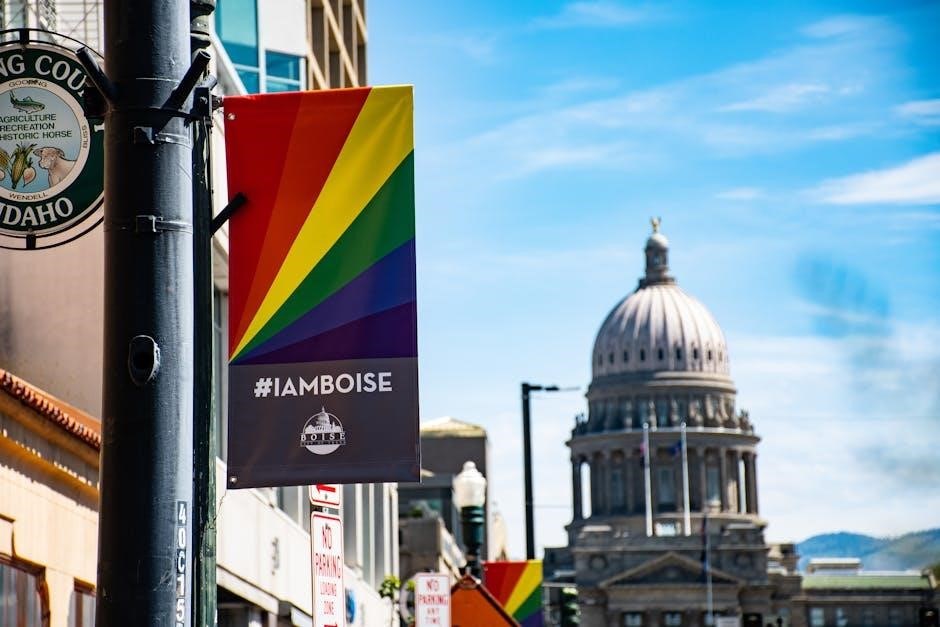“I Am Malala” is a powerful memoir by Nobel Peace Prize winner Malala Yousafzai, detailing her courageous fight for girls’ education and survival against Taliban oppression.
1.1 Background and Significance of the Autobiography
“I Am Malala” is a deeply personal and inspiring memoir that chronicles Malala Yousafzai’s life, from her childhood in Swat Valley to her global advocacy for girls’ education. Co-authored with Christina Lamb, the book was first published in 2013 and has since become an international bestseller. It provides a vivid account of Malala’s experiences under Taliban rule, her family’s dedication to education, and her survival of a brutal assassination attempt. The autobiography is significant for its raw honesty and its ability to highlight the struggles faced by girls in regions where education is suppressed. Malala’s story has resonated globally, making her a symbol of courage and resilience. The book not only shares her personal journey but also sheds light on the broader fight for women’s rights and education worldwide. Its impact has been profound, inspiring millions to stand up for equality and education.
1.2 Overview of the Book’s Content and Structure
“I Am Malala” is structured to take readers on a journey through Malala Yousafzai’s life, from her early years in Swat Valley to her global advocacy. The book is divided into chapters that chronicle her childhood, the rise of the Taliban, and her family’s commitment to education. It details her early activism, the assassination attempt, and her remarkable recovery. Co-authored with Christina Lamb, the memoir offers a personal and reflective narrative, blending cultural insights with a universal message of resilience. The book also includes a young readers’ edition, adapted by Patricia McCormick, making it accessible to a broader audience. This structure ensures a comprehensive understanding of Malala’s experiences and her mission to champion girls’ education worldwide. The clear and engaging format has contributed to its global acclaim and accessibility.
Early Life of Malala Yousafzai
Malala Yousafzai was born in Swat Valley, Pakistan, to a family deeply committed to education. Her father, Ziauddin, an educator, nurtured her love for learning and activism from an early age.
2.1 Birth and Upbringing in Swat Valley, Pakistan
Malala Yousafzai was born on July 12, 1997, in Mingora, Swat Valley, Pakistan. Her father, Ziauddin Yousafzai, a school owner and educator, instilled in her a love for learning and activism. Malala grew up in a region once known for its beauty and peace but increasingly dominated by Taliban influence. Her upbringing in a culturally rich yet politically volatile environment shaped her early awareness of social injustices. From a young age, Malala exhibited a fierce determination to stand up for girls’ education, inspired by her father’s advocacy. Her family’s commitment to education and equality laid the foundation for her future as a global advocate for women’s rights and education.

2.2 Family Dynamics and Father’s Influence
Malala’s family played a pivotal role in shaping her character and mission. Her father, Ziauddin Yousafzai, a school owner and outspoken advocate for girls’ education, deeply influenced her. He encouraged her to speak out against the Taliban’s efforts to deny girls education. Malala’s mother, Tor Pekai, though less publicly involved, supported her daughter’s education and household responsibilities. The family’s emphasis on education and equality created a nurturing environment for Malala’s activism. Her father’s courage and belief in her abilities instilled in her the confidence to challenge societal norms. This familial support system was instrumental in fostering Malala’s resilience and determination to fight for girls’ education, even in the face of extreme adversity.

The Rise of the Taliban in Swat Valley
The Taliban’s takeover transformed Swat Valley, imposing strict rules and banning girls’ education. Their oppressive regime sparked fear and resistance, shaping Malala’s determination to fight for change.
3.1 The Taliban’s Takeover and Restrictions
The Taliban’s takeover of Swat Valley brought severe restrictions, banning music, women from markets, and girls from schools. Their oppressive regime enforced strict Islamic law, silencing dissent and fostering fear.
3.2 Impact on Women’s Rights and Education
The Taliban’s rule severely curtailed women’s rights and access to education in Swat Valley. Girls were barred from attending school, and women faced strict restrictions on public appearances and activities. The Taliban enforced a rigid interpretation of Islamic law, deeming education for girls as immoral and Western influence. This led to the closure of girls’ schools, forcing many to abandon their studies. Malala’s father, Ziauddin Yousafzai, defied these restrictions by running a school for girls, emphasizing the importance of education despite the risks. The Taliban’s oppressive measures not only denied girls their right to learn but also perpetuated a cycle of ignorance and inequality, further marginalizing women in society. This oppressive environment fueled Malala’s determination to challenge the Taliban and advocate for girls’ education.

Malala’s Advocacy for Girls’ Education
Malala Yousafzai became a global advocate for girls’ education, challenging the Taliban’s restrictions and inspiring millions through her courage and determination to fight for equality and learning.
4.1 Early Activism and Blogging
Malala’s advocacy began at just 11 years old when she started blogging for the BBC about life under Taliban rule, highlighting the denial of girls’ education and the horrors of war. Her father, Ziauddin, a vocal educator, encouraged her to speak out, fostering her passion for equality. Malala’s blog gained international attention, making her a symbol of resistance against oppression. She wrote about the Taliban’s bans on education, music, and women’s freedoms, risking her safety to give voice to the voiceless. Her early activism laid the foundation for her global influence, showcasing her courage and determination to challenge injustice, even in the face of extreme danger. This marked the beginning of her journey as a fearless advocate for girls’ education and human rights.
4.2 Speaking Out Against the Taliban
Malala’s activism escalated as she began speaking out publicly against the Taliban’s oppressive regime, advocating for girls’ education and challenging their efforts to silence women. She appeared in media interviews and documentaries, such as the New York Times film “Class Dismissed,” sharing her story and demanding change. In 2011, she delivered a powerful speech in Peshawar, titled “How Dare the Taliban Take Away My Basic Right to Education?” This bold declaration of defiance made her a prominent figure in the fight against Taliban extremism. Her outspokenness drew global attention and solidarity, but it also made her a target. The Taliban, threatened by her influence, issued a death threat against her, marking the beginning of a dangerous chapter in her life. Malala’s courage in the face of such adversity solidified her role as a global advocate for justice and equality.
The Assassination Attempt
“I Am Malala” recounts the harrowing day when Malala was shot by the Taliban on October 9, 2012, while returning from school in Swat Valley. The attack, intended to silence her advocacy, instead amplified her message globally, sparking widespread outrage and support for her cause.
5.1 The Day of the Shooting
On October 9, 2012, Malala Yousafzai’s life changed forever. While returning from school in Swat Valley, a Taliban gunman boarded her bus, demanding to identify her. Refusing to hide, Malala was shot in the head at point-blank range. The attack also injured two other girls. The shooting sparked global outrage and solidarity, as Malala’s condition captivated the world. Flown to a military hospital in Peshawar, she underwent emergency surgery to remove the bullet, which had grazed her brain. Her survival was deemed a miracle, and her recovery became a symbol of resilience. The attempt on her life failed to silence her; instead, it amplified her voice, inspiring millions to stand with her for girls’ education and human rights.
5.2 Immediate Aftermath and Recovery

Following the shooting, Malala was rushed to a military hospital in Peshawar, where she underwent emergency surgery to remove a bullet lodged near her spinal cord. Her condition remained critical, sparking global concern. As her story captivated the world, Malala was airlifted to a specialized hospital in Rawalpindi and later to the UK for further treatment. The international community rallied around her, offering prayers and support. During her recovery, Malala defied expectations, demonstrating remarkable resilience. Her survival became a symbol of hope and defiance against oppression. The attempt on her life failed to silence her; instead, it amplified her message, inspiring global advocacy for girls’ education and solidifying her role as a global icon of courage and determination.
Global Reaction and Support
Malala’s survival and courage sparked global solidarity, with widespread condemnation of the Taliban’s actions. Her story inspired international advocacy for girls’ education, amplifying her influence worldwide.
6.1 International Outcry and Solidarity
The attempted assassination of Malala Yousafzai by the Taliban in 2012 sparked a global wave of outrage and solidarity. People worldwide condemned the attack, rallying behind her cause for girls’ education. The incident drew unprecedented international attention, highlighting the plight of women under Taliban rule. Malala’s survival and continued advocacy transformed her into a global symbol of resilience and courage. Her story resonated across cultures, inspiring movements and sparking conversations about gender equality and education. The international community united in support, amplifying her message and ensuring her voice reached every corner of the globe. This solidarity not only elevated her platform but also pressured governments to address educational disparities and human rights issues.
6.2 Malala’s Rising Global Influence
Malala Yousafzai’s near-assassination catapulted her to global prominence, transforming her into an international symbol of courage and advocacy. At just 15, she became the youngest Nobel Peace Prize laureate, solidifying her status as a global icon. Her message of equality and education resonated worldwide, inspiring millions. Collaborations with global organizations and world leaders amplified her influence, enabling her to address the United Nations and meet with heads of state. The publication of I Am Malala further expanded her reach, with the book becoming a bestseller in multiple languages. The autobiography’s digital versions, including the PDF, ensured accessibility, spreading her story to a broader audience. Malala’s influence continues to grow, as she remains a powerful voice for human rights and education, challenging injustices and inspiring change on a global scale. Her legacy endures, shaping conversations and policies worldwide.
The Autobiography’s Publication and Reception

I Am Malala was published in 2014, becoming a bestseller and receiving critical acclaim. The PDF version enhanced its accessibility, furthering its global influence and educational impact.
7.1 Publication Details and Editions
“I Am Malala” was first published in hardcover in August 2014 by Little, Brown and Company. The book is available in multiple formats, including paperback, e-book, and a young readers edition co-authored with Patricia McCormick. The PDF version has gained significant popularity for its accessibility, allowing readers worldwide to access Malala’s story easily. The memoir has been translated into numerous languages and is widely available on platforms like Amazon, Barnes & Noble, and Target. Its publication marked a milestone in storytelling, inspiring millions and cementing Malala’s legacy as a global advocate for education. The book’s widespread availability in various formats has ensured its reach and impact, making it a New York Times bestseller and a critically acclaimed work.
7.2 Critical Acclaim and Reviews
“I Am Malala” has received widespread critical acclaim for its powerful narrative and inspiring message. Reviewers praise Malala’s courage and resilience, calling the memoir a testament to the human spirit. The book has been described as a “remarkable” and “stunning story of resilience and power” by Marie Claire and the New York Times, respectively; Readers worldwide have praised the autobiography for its engaging storytelling and insightful look into life in Pakistan. The collaboration with Patricia McCormick in the young readers’ edition has also been commended for making the story accessible to a younger audience. The PDF version has further amplified its reach, ensuring Malala’s message of education and equality resonates globally. The memoir’s impact has solidified its place as a modern classic, inspiring countless readers to advocate for change.

Key Themes in “I Am Malala”
Education, resilience, and the fight for women’s rights are central themes, highlighting Malala’s courage against oppression and her belief in education as a transformative force.
8.1 Education as a Fundamental Right
In I Am Malala, education is portrayed as a cornerstone of human rights, especially for girls. Malala’s journey highlights the Taliban’s efforts to deny girls schooling, emphasizing how education empowers individuals and societies. Her advocacy underscores the belief that learning is essential for personal and collective progress, challenging oppressive systems. The memoir vividly illustrates the transformative power of education, inspiring global movements to ensure access for all. Through her story, Malala reinforces the idea that education is not just a privilege but a fundamental right that no one should be denied.
8.2 Resilience and Courage in the Face of Adversity
Malala’s autobiography vividly illustrates her extraordinary resilience and courage in the face of overwhelming adversity. Despite the Taliban’s threats and the attempted assassination, she refused to be silenced, embodying strength and determination. Her survival and continued advocacy for girls’ education highlight her unwavering commitment to justice. The memoir reveals her personal struggles, including balancing her global mission with the challenges of being a teenager. Malala’s courage inspires readers, showing how one person can challenge oppressive systems and spark global change. Her story is a testament to the power of resilience, proving that even in the darkest times, hope and determination can prevail. Her bravery continues to motivate millions worldwide to stand up for their rights and fight for a better future.

The PDF Version’s Popularity
The PDF version of “I Am Malala” has gained immense popularity due to its accessibility and widespread reach, inspiring readers globally with its powerful narrative of resilience and courage.
9.1 Accessibility and Reach of the Digital Format
The digital format of “I Am Malala” has significantly enhanced its accessibility, allowing readers worldwide to easily access the memoir. The PDF version is widely available on platforms like Amazon, Barnes & Noble, and other online retailers, ensuring that Malala’s story reaches a global audience. This digital accessibility has played a crucial role in spreading her message of resilience and advocacy for girls’ education. The convenience of the PDF format enables readers to engage with the book on various devices, further amplifying its impact and ensuring that Malala’s voice continues to inspire people across different regions and cultures.
9.2 Impact on Global Readership
The PDF version of “I Am Malala” has profoundly impacted global readership by making the memoir accessible to diverse audiences. Its digital availability has transcended geographical barriers, allowing readers in remote and underserved areas to connect with Malala’s story. The widespread distribution of the PDF has also facilitated discussions in educational institutions and book clubs, fostering a deeper understanding of global issues. Additionally, the digital format has enabled younger readers to engage with the content, inspiring a new generation of activists. The memoir’s global reach has not only amplified Malala’s message but also created a unified movement advocating for education and equality, proving the power of digital media in spreading impactful narratives worldwide.

Malala’s Continued Advocacy
Malala Yousafzai remains a global advocate for girls’ education, continuing her mission through the Malala Fund, inspiring millions to stand up for educational equality worldwide.

10.1 The Malala Fund and Its Mission
The Malala Fund, established by Malala Yousafzai and her father, Ziauddin Yousafzai, is a nonprofit organization dedicated to breaking the barriers that prevent girls from accessing education. The fund works in regions where girls are denied educational opportunities due to poverty, war, and discrimination. By partnering with local leaders and organizations, the Malala Fund supports education projects that empower girls to attend school and advocate for their rights. The organization also raises awareness about the importance of girls’ education globally, amplifying the voices of girls and women who are fighting for equality. Through its efforts, the Malala Fund envisions a world where every girl can learn, grow, and lead, fulfilling her potential and inspiring positive change in her community and beyond.
10.2 Ongoing Efforts for Girls’ Education
Malala Yousafzai continues to champion girls’ education globally through the Malala Fund and its initiatives. The fund supports education programs in countries like Pakistan, Afghanistan, and Nigeria, where girls face significant barriers to learning. By advocating for policy changes and challenging cultural norms, Malala and her team work to ensure that girls have access to safe, quality education. The Gulmakai Network, a program of the Malala Fund, trains local educators and activists to advocate for girls’ education in their communities. Malala’s efforts have inspired millions worldwide, emphasizing that education is a fundamental right for all girls. Her ongoing work remains a testament to her unwavering commitment to creating a more equitable and educated world.
The Book’s Legacy and Impact
“I Am Malala” has become a global symbol of courage, inspiring millions to fight for education and equality. Its impact continues to spark meaningful conversations worldwide.
11.1 Inspiring a Generation of Activists
Malala Yousafzai’s autobiography has ignited a global movement, inspiring countless young people to stand up for their rights and advocate for change. Her story of resilience and courage has empowered individuals, particularly girls, to challenge societal norms and fight for education. The book has sparked widespread discussions, motivating readers to take action in their communities. Many young activists have credited Malala’s journey as a catalyst for their own advocacy efforts, proving that one person’s voice can inspire a generation. By sharing her experiences, Malala has created a ripple effect, encouraging others to pursue justice and equality. Her legacy continues to grow, shaping a new wave of leaders committed to making a difference.
11.2 Cultural and Social Change
Malala’s autobiography has driven significant cultural and social change, challenging oppressive norms and advocating for girls’ education globally. Her story has shifted perceptions, fostering empathy and understanding. The book highlights the importance of education as a tool for empowerment, inspiring reforms in education policies worldwide. Malala’s message has resonated across cultures, uniting people in the fight against inequality. By sharing her experiences, she has dismantled stereotypes and encouraged dialogue about women’s rights. The impact of her work is evident in the growing number of initiatives supporting girls’ education, proving that individual efforts can lead to widespread transformation. Malala’s legacy continues to inspire, creating a more inclusive and equitable world.
Malala’s journey from Swat Valley to global advocacy underscores the power of courage and education; Her story inspires hope and action for equality and justice worldwide.
12.1 Summary of Malala’s Journey
Malala Yousafzai’s journey is a testament to resilience and determination. Born in Swat Valley, Pakistan, she grew up in a region increasingly dominated by the Taliban, who sought to deny girls education. Inspired by her father, an educator and activist, Malala began advocating for girls’ education at a young age. Her activism gained global attention through her blogging and interviews, which criticized the Taliban’s restrictions. In 2012, she survived an assassination attempt by the Taliban, which sparked international outrage and solidified her role as a global symbol of courage. After recovering, Malala continued her advocacy, co-founding the Malala Fund and becoming the youngest Nobel Peace Prize laureate. Her autobiography, I Am Malala, chronicles her journey, offering a powerful narrative of hope, resilience, and the fight for education as a fundamental human right.
12.2 The Enduring Message of “I Am Malala”
The enduring message of I Am Malala lies in its universal call for education, equality, and resilience. Malala’s story transcends cultural boundaries, inspiring millions to stand against oppression and fight for their rights. Her autobiography emphasizes the transformative power of education, particularly for girls, and challenges societal norms that restrict women’s opportunities. The book also highlights the importance of family and community support in fostering courage and determination; Malala’s unwavering commitment to her cause serves as a beacon of hope, reminding readers that one voice can spark global change. Through her journey, she underscores the resilience of the human spirit and the unyielding pursuit of justice, leaving a lasting legacy that continues to inspire future generations.